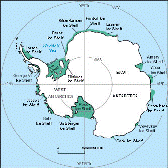Antarctic Drilling Program (ANDRILL)

ANDRILL Related Publications of Affiliates
Document Type
Article
Date of this Version
2007
Abstract
Volcanic sills and dikes inferred from seismic reflection profiles and geophysical studies of the Ross Sea are thought to be related to the rift basins in the region, and their emplacement to be coeval with extension. However, lack of precise geochronology in the Terror Rift of the Ross Sea region has left these inferred relationships poorly constrained and has hindered neotectonic studies, because of the large temporal gaps between seismic reflectors of known ages. New 40Ar/39Ar geochronology presented here for submarine volcanic rocks provides better age constraints for neotectonic interpretations within the Terror Rift. Several samples from seamounts yielded young ages between 156 ± 21 and 122 ± 26 Ka. These ages support interpretations that extension within the Terror Rift was active at least through the Pleistocene. Three evenly spaced samples from the lowermost 100 m of Franklin Island range in age from 3.28 ± 0.04 to 3.73 ± 0.05 Ma. These age determinations demonstrate that construction of a small volcanic edifice such as Franklin Island took at least several hundred thousand years, and therefore that much larger ones in the Erebus Volcanic Province are likely to have taken considerably longer than previously inferred. This warrants caution in applying a limited number of age determinations to define the absolute ages of events in the Ross Sea region.


Comments
Citation: Rilling, S.E., S.B. Mukasa, T.J. Wilson, and L.A. Lawver (2007), 49Ar-39Ar Age Constraints on Volcanism and Tectonism in the Terror Rift of the Ross Sea, Antarctica, in Antarctica: A Keystone in a Changing World – Online Proceedings of the 10th ISAES, edited by A.K. Cooper and C.R. Raymond et al., USGS Open-File Report 2007-1047, Short Research Paper 092, 4 p.; doi:10.3133/of2007-1047.srp092.